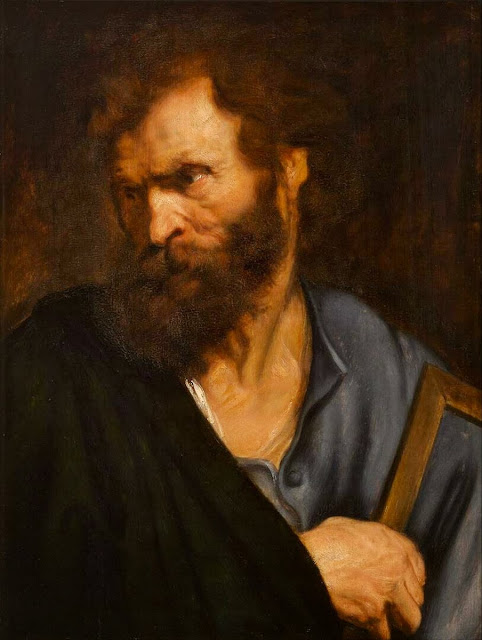A Closer Look at an Obscure Apostle
 |
Judas Thaddeus by Jan Oldrich Mayer
|
1. Who is this 'Judas Thaddeus', Anyway?
In the Apostle lists of the gospels of Matthew and Mark, immediately after James the son of Alpheus, comes Thaddeus, and then Simon the Zealot. The name Thaddeus is not mentioned again in the entire Bible. In the apostle list of the Gospel of Luke, Simon Zealot's name comes after James Alpheus, and then comes a new name: "Judas [son of] James" (not [brother of], which is a mis-translation). This is an extra Judas, differentiated from Judas Iscariot, who betrayed Jesus. Luke doubles down on the name and parentage in Acts 1:13. This extra Judas show up once in John's Gospel, identified as "Judas, not Iscariot" (John 14:22). Only John gives him a speaking part: "Are you going to disclose yourself to us, and not to the world?"
It didn't take long for the ancient church fathers to identify this extra Judas as being the same as Thaddeus. In church tradition they began calling him "Jude" to differentiate him from "Judas Iscariot." But then later church fathers confused Jude the Apostle with Jude the step-brother of Jesus, and further confounded him as the author of the short letter of Jude. Recent scholarship has pretty much nailed down who was the author of the letter of Jude. By a great margin, it could be none other than Judas (Jude), the youngest step-brother of Jesus. It is a very early letter (perhaps the earliest), with a strict structure that carefully imitates the pesher letters found in the Dead Sea Scrolls.
 |
| Judas Thaddeus by Anthony van Dyck |
Could Judas Thaddeus be the Youngest Apostle?
The youngest apostle, at least in the realm of art, has always been assumed to be John son of Zebedee, who is always portrayed as the only apostle lacking facial hair. That is, John was thought to be too young to have grown a beard. He was identified as the "disciple whom Jesus loved," presumably because due to his youth, he needed extra guidance from the Master. And by my analysis, he was the "least" disciple, that is, the one whose job was to attend to the personal needs of the Master and would stay beside him when the remaining apostles had jobs to do, such as fetching food from a Samaritan town while Jesus rested by the well.
But there is another possibility, and this depends on identifying "James" the father of Judas Thaddeus. In the lists of Luke and Acts, Judas [Thaddeus] is separated from James Alpheus only by one name. In the lists of Matthew and Mark, [Judas] Thaddeus comes directly after James Alpheus. Scholars complain that James (actually, Jacob) is such a common name that there is no hope of identifying Thaddeus' father. But the close mentions of Judas T. with James A. likely betrays the possibility that everyone who wrote the synoptic gospels plus the intended early audience for these gospels already knew the identity of the father of Judas Thomas.
This makes James Alpheus and Judas Thaddeus James the only father & son team among the apostles. (Thaddeus seems to be a nickname.) Neither of these men were part of the first group of disciples, composed of professional fishermen and their friends. When they joined Jesus, Thaddeus could have just recently passed his bar Mitzvah and be a year or two younger than John of Zebedee. And he would not be in need of special extra attention from Jesus, because he worked directly at his own father's side.
Mark's gospel identifies the six working pairs among the apostles: 1) Peter and James Z, the older members of the fishing consortium, 2) John Z and Andrew, the younger members of the fishing consortium, 3) Philip and Nathanael bar Tholmai, friends of the consortium, 4) James son of Alpheus and Thaddeus grandson of Alpheus, 5) Matthew and Thomas, the carpenter/architect and the tax collector, and finally 6) Simon the Zealot and Judas son of the Man from Kerioth.
 |
| Judas Thaddeus with Healing Image of Christ |
The Acts of Judas Thaddeus
In church tradition, the evangelistic work of Thaddeus was prodigious. He made disciples of Jesus in Judea, Idumea, Samaria, Syria, Persia, Libya, Beirut, and most famously, Edessa in Syria. Thaddeus brought to King Abgar of Edessa an image of Jesus, which the king looked upon and became cured of his disease. Later speculation identifies this image with the Shroud of Turin. In any case, the king became a follower of Jesus and spread the way as the newly official religion of Syria. (Other sources propose that Thaddeus of Edessa may have been a different person than Thaddeus the Apostle.)
 |
| Prayer Medallion for the Lost Cause Apostle |
The Apostle of Lost Causes
One story holds that, because Thaddeus shared a name with the traitor Iscariot, people were reluctant to come to him for help. This made Thaddeus even more encouraged to accept any call for help he received. So when people in need exhausted every other avenue, they turned to Thaddeus, the Apostle for Lost Causes.
And (below), it seems that Thaddeus has not been totally forgotten, for someone has written a screen play about his life and ministry.
 |
| A Screenplay for Thaddeus |
Post #71
No comments:
Post a Comment